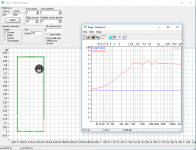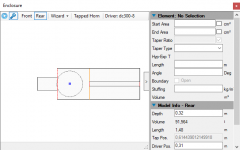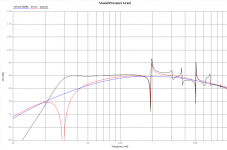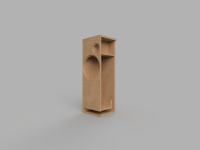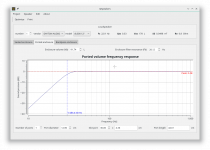I have apair of Markaudio CHR-70's I'm not using anymore. I always liked their sound, but not the lack of bass, and am now investigating what to do with them.
I like the DC300 because they are cheap, look good on paper, and look good.
But the CHR-70 are 85db, and I wanted to cross them as low as possible. If I use the fullranger's jargon, I want to make a FAST. But if I'm right, the lower I want to cross, the wider the baffle should be? Or should I just buy new widerangers?
.
I like the DC300 because they are cheap, look good on paper, and look good.
But the CHR-70 are 85db, and I wanted to cross them as low as possible. If I use the fullranger's jargon, I want to make a FAST. But if I'm right, the lower I want to cross, the wider the baffle should be? Or should I just buy new widerangers?
.
Smoke 'em if you got 'em chappies -(i.e. use the CHRs) and to keep up with the current vernacular, that'd be a WAW. The easiest way to deal with different sensitivities of drivers would be to bi-amp with a passive line level XO. I could be going out on a limb, but I'd imagine most DIY speaker builders might already have extra amps easily recruitable for the duty.
proposed enclosure?
Hi there p: What type of enclosure are you proposing? Knowing this would allow others on the forum to assist you in choosing a baffle dimension. I've used several Dayton drivers, with good results, should work acceptably with the CHR's in a FAST/WAWA. ...regards Michael
I have apair of Markaudio CHR-70's I'm not using anymore. I always liked their sound, but not the lack of bass, and am now investigating what to do with them.
I like the DC300 because they are cheap, look good on paper, and look good.
But the CHR-70 are 85db, and I wanted to cross them as low as possible. If I use the fullranger's jargon, I want to make a FAST. But if I'm right, the lower I want to cross, the wider the baffle should be? Or should I just buy new widerangers? .
Hi there p: What type of enclosure are you proposing? Knowing this would allow others on the forum to assist you in choosing a baffle dimension. I've used several Dayton drivers, with good results, should work acceptably with the CHR's in a FAST/WAWA. ...regards Michael
Thank you al for your replies so far.
@chrisb: bi-amping is something I thought of already, but thought that it is a whole new project on top of this one. Of course, like any DIYer, I have maybe half a dozen different class D amps, but use a simple class A at the moment and love it. If I went this way, I might just as well make speakers active and save on power supplies
Drivers in the speakers in the posted link have very similar sensitivity, the woofers being a little less sensitive. I don't know the exact theory about where loudness goes when connecting identical drivers parallel... but from the back of my head, going from 8 to 4 ohm boosts it by 3db. Making the response "flatish".
As for the enclosure: I thought about ~100L bass reflex but am totally open for suggestions.
The woofer used should be a 12", because I really wish to make an econowave once I find a good deal on decent CD's somewhere in the EU where shipping won't be a s criminal as from partsexpress
@chrisb: bi-amping is something I thought of already, but thought that it is a whole new project on top of this one. Of course, like any DIYer, I have maybe half a dozen different class D amps, but use a simple class A at the moment and love it. If I went this way, I might just as well make speakers active and save on power supplies
Drivers in the speakers in the posted link have very similar sensitivity, the woofers being a little less sensitive. I don't know the exact theory about where loudness goes when connecting identical drivers parallel... but from the back of my head, going from 8 to 4 ohm boosts it by 3db. Making the response "flatish".
As for the enclosure: I thought about ~100L bass reflex but am totally open for suggestions.
The woofer used should be a 12", because I really wish to make an econowave once I find a good deal on decent CD's somewhere in the EU where shipping won't be a s criminal as from partsexpress
peroz,
Is the DC300 available at your place? Have you done any cabinet modelling on how the driver looks in a ~100 liter BR box?
I am no expert, but assuming woofer assisted wide-band, you will end up crossing the CHR-70 below 500 Hz, and the passive XO parts are likely going to cost a bit.
Is the DC300 available at your place? Have you done any cabinet modelling on how the driver looks in a ~100 liter BR box?
I am no expert, but assuming woofer assisted wide-band, you will end up crossing the CHR-70 below 500 Hz, and the passive XO parts are likely going to cost a bit.
Last edited:
I looked at the dc250 now... seems to have roughly the same sensitivity as the CHR-70. Won't look as sexy as the 300, and probably won't use it in the next project, but anyway... would you guys say it is a more sensible choice?
I kind of decided not to go the PLLXO way, as people complain about it being a long trial and error path, possibly making the sound flat and dull.
Damn, I knew I shouldn't have started this multi-way journey
How is this for an idea:
I take the dc300, and make it help the chr70 to the point of baffle step "with its slope". Would it work? I hope I expressed myself clear enough... don't know how to put it.
I kind of decided not to go the PLLXO way, as people complain about it being a long trial and error path, possibly making the sound flat and dull.
Damn, I knew I shouldn't have started this multi-way journey
How is this for an idea:
I take the dc300, and make it help the chr70 to the point of baffle step "with its slope". Would it work? I hope I expressed myself clear enough... don't know how to put it.
It's just as easy to poorly design a passive XO system that sounds flat and dull - or worse, as one using PLLXO / bi-amp.
One of the major advantages to the latter approach is that assuming you've got the required amps available, the cost of parts to provide the filter functions a low voltage / higher impedance levels will be much lower.
No matter which approach you take, it's always more advantageous to relieve the small wide-band driver of as much of the heavy lifting below around 300Hz as you can. Between 300 and, say 100Hz - unless in a very small room where localization won't be an issue - you'll want to go with bass support for each channel. They needn't be in the same enclosure.
One of the major advantages to the latter approach is that assuming you've got the required amps available, the cost of parts to provide the filter functions a low voltage / higher impedance levels will be much lower.
No matter which approach you take, it's always more advantageous to relieve the small wide-band driver of as much of the heavy lifting below around 300Hz as you can. Between 300 and, say 100Hz - unless in a very small room where localization won't be an issue - you'll want to go with bass support for each channel. They needn't be in the same enclosure.
Last edited:
... seems to have roughly the same sensitivity as the CHR-70...
With a passive XO you usually want the sensitivity of the woofer to be greater than the midTweeter and crossover somewhere in the range of 0.707-1 times the baffle step F3.
With a PLLXO (way easy than a passive XO but not as flexible) the sensitivities don’t really matter, you adjust the end levels with the gain controls on the amps.
dave
I felt spendy for a moment and just ordered the big Daytons 
Now I started playing with different simulators and design tools to come up with a viable design and found out the boxes will be very big. And heavy, which is good because I have small children.
The difference in sensitivity should kind of compensate with baffle step. The results of Edge are in the attachment.
I simulated frequency response with Leonard Audio Transmisson line and QSpeakers. Results are more or less the same: -3dB@30Hz.
Sims told me to make very big and long ports so I drew what I drew, but am thinking of maybe trying to do something with pvc pipes if that is an okay idea?
Please, review my attachments and let me know if there are any obvious and rookie design flaws. I know size will have to be recalculated when I know the thickness of the material and what I will do about the port, but this is basically it.
Now I started playing with different simulators and design tools to come up with a viable design and found out the boxes will be very big. And heavy, which is good because I have small children.
The difference in sensitivity should kind of compensate with baffle step. The results of Edge are in the attachment.
I simulated frequency response with Leonard Audio Transmisson line and QSpeakers. Results are more or less the same: -3dB@30Hz.
Sims told me to make very big and long ports so I drew what I drew, but am thinking of maybe trying to do something with pvc pipes if that is an okay idea?
Please, review my attachments and let me know if there are any obvious and rookie design flaws. I know size will have to be recalculated when I know the thickness of the material and what I will do about the port, but this is basically it.
Attachments
Thinking some more... the problem might be the nearness of woofer to the FR unit... diffraction and stuff?
hi,
theorically the woofer to FR centre to centre distance should be at most 1/4 wavelength of crossover frequency for best integration of both drivers (there is acoustic coupling if you follow this rule and both drivers should appears as one and only source).
E.G.: if you cut at 343hz so wavelength is 1m, so center to center spacing should be at most 25cm.
This may lead to some diffraction issues yes, but imho you'll end with diffraction issues anyway (as almost all loudspeakers) and to have the drivers not to integrate well may be more troublesome than diffraction.
From the pictures you linked in your post everything should be ok from my opinion ( or not worst than other implementation). This look like typical implementation for me, offset of Fullrange should help about diffraction and if you round the edge of box it should be even better.
Last edited:
E.G.: if you cut at 343hz so wavelength is 1m, so center to center spacing should be at most 25cm.
So it the xo frequency is even lower, the drivers can easily be placed even farther apart. Good to know.
Okay, as long as it isn't worse than other projects....or not worst than other implementation). This look like typical implementation for me, offset of Fullrange should help about diffraction and if you round the edge of box it should be even better.
I can't think of a way to better integrate two drivers like this, but if anyone has an idea, please share.
A construction question:
I drew the blue line to measure the lenght of the port and it seems I need that small "lip" over there to make it 45cm. Did I measure the lenght correctly? Is there a better way of constructing ports like this? Maybe make the turn sooner and make the additional wall also act as bracing?
I drew the blue line to measure the lenght of the port and it seems I need that small "lip" over there to make it 45cm. Did I measure the lenght correctly? Is there a better way of constructing ports like this? Maybe make the turn sooner and make the additional wall also act as bracing?
Attachments
A construction question:
I drew the blue line to measure the lenght of the port and it seems I need that small "lip" over there to make it 45cm. Did I measure the lenght correctly? Is there a better way of constructing ports like this? Maybe make the turn sooner and make the additional wall also act as bracing?
Not really a surprise that there's a wealth of opinion and debate but hopefully the following article is factual.
Horn Folding - a brief study of the centerline vs advanced centerline method - AVS Forum | Home Theater Discussions And Reviews
J.
- Status
- This old topic is closed. If you want to reopen this topic, contact a moderator using the "Report Post" button.
- Home
- Loudspeakers
- Multi-Way
- My first two way (Markaudio+Dayton)
